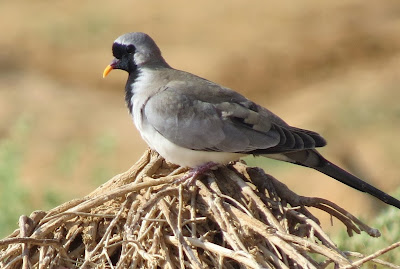It hadn't rained much in Buraidah by Friday but the wadi valley held a surprising amount of water as well as fish. I can only assume the water had found a way to travel from the west which had had plenty of rain.
grey heron
The valley was lush with short reeds and grass. It was also quiet probably because it was Friday morning in a devout area.
Wadi Rummah
The large birds are often seen first. A flock of little egret were an obvious presence alongside a single grey heron. Their peace was only disturbed by us and once by a marsh harrier.
little egret
Slightly unusually the only other member of the heron family we saw was a little bittern.
Wood sandpiper
There were plenty of waders. The most common was wood sandpiper.
wood sandpiper with yellow wagtail (lutea)
While watching three of them, Bernard bracken caught sight of a yellow wagtail. This was a strange sight. A very few yellow wagtail winter in Kharj 80 kilometres south east of Riyadh but I never expected to see one at Buraidah which is 350 kilometres north west.
It will surely move on when it realises how cold it gets at night in winter there. However there is no doubt this section of Wadi Rummah is an unusual micro habitat.
White wagtail were common not surprisingly.
wood sandpiper (front) with little stint
Little stint were the second most common wader. The picture above shows it in less usual terrain. Most were seen on the river/water's banks.
wood sandpipers with a curlew sandpiper and Temminck's stint
The third wader observed was common snipe. There were plenty which unfortunately were always one step ahead of us.
The final waders were curlew sandpiper and Temminck's stint. Both are in the picture above. The curlew sandpiper is towards the right while the small wader at the back of the two wood sandpipers on the left is a Temminck's stint. Thanks to the people on BirdForum for help in identifying these two.
Moorhen was another water bird present.
bluethroat
The terrain looked good for bluethroat though only one was actually seen.
immature red-backed shrike
The yellow wagtail was not the only late migrant observed. A solitary barn swallow flew overhead and then we came across an immature red-backed shrike.
back view of immature red-backed shrike
It was a prime example of an immature bird. It had crescentic barring not only on the sides and mantle but also on its crown.
hoopoe
Since we were probably the first birders ever in this place, we made note of resident birds though hoopoe could be wintering or resident.
Namaqua dove
All the same three resident doves as in Riyadh were easily seen: European collared dove, Laughing dove and Namaqua dove. We were well within the known range of black bush robin.
white-eared bulbul
White-eared bulbul is expanding its range north and west and probably conquered this area a long time ago.
Wadi Rummah must be even more interesting now the rains have come to central Arabia. Since Saturday it hasn't stopped raining!














Nice Pics Rob. You did well to ID that little sandpiper, I could hardly see it until I read the text.
ReplyDelete